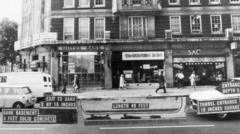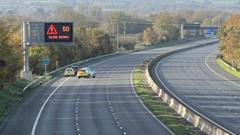
In September 1971, a group of skilled criminals executed one of the most audacious bank heists in British history at the Lloyds Bank branch on Baker Street in London. The meticulously planned robbery involved tunneling into the bank’s vault from a nearby leather goods shop and stealing the contents of hundreds of safety deposit boxes.
The gang’s preparation was extensive and precise. Benjamin Wolfe, a man in his 60s, purchased the leather shop specifically because its basement was at the same depth as the bank’s vault. One of the gang members had previously opened a bank account and repeatedly visited the vault, using an umbrella to secretly measure the room during these visits.
Fortuitously for the criminals, recent roadworks in the area had caused frequent trembler alarms, leading businesses to disable their security systems. The gang spent months carefully digging a 40-foot tunnel, removing debris under the cover of darkness. Their team included Thomas Stephen, who provided specialized equipment like a 100-tonne jack, explosives, and a thermal lance.
During the actual heist, the gang used gelignite to break through the vault floor, timing the explosion to coincide with traffic noise. Bobby Mills was stationed on a nearby roof as a lookout, equipped with a walkie-talkie. Remarkably, an amateur radio operator named Robert Rowlands inadvertently intercepted their communications, hearing their conversations in real-time.
The robbery was so precise that when police and bank security initially checked the premises, they were assured the strong room was intact. The thieves were literally crouching behind the vault doors during this inspection, narrowly avoiding detection.
Four members of the gang were eventually caught and sentenced. Anthony Gavin, Reginald Tucker, Thomas Stephen, and Benjamin Wolfe were convicted of trespassing, theft, and possessing explosives. Wolfe received a lighter eight-year sentence due to his advanced age, while the others got 12-year terms.
The total amount stolen remains uncertain, with estimates ranging from £500,000 to £3 million. Only a fraction was ever recovered, and many questions about the heist remain unanswered.
The case spawned numerous rumors, including speculation about compromising photographs of Princess Margaret and potential government cover-ups. A 2008 film, “The Bank Job,” was inspired by the events, further mythologizing the robbery.
Interestingly, the documents related to the heist are sealed at the National Archives until 2071, adding to the mystery surrounding the case. Lloyds Bank’s response was notably pragmatic, advising customers to insure their valuables and noting that it was “a little unusual for raiders to come up through the floor.”
The Baker Street robbery remains one of the most fascinating unsolved mysteries in British criminal history, a testament to meticulous planning, audacious execution, and remarkable luck.








